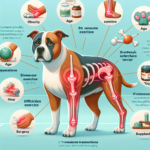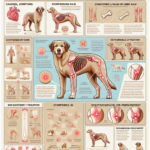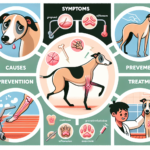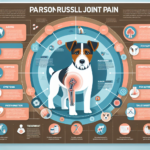Labrador Retriever Joint Pain: Causes, Symptoms, Prevention, and Treatment

Introduction
Overview of Labrador Retriever: The Labrador Retriever, often simply called the Labrador or Lab, is one of the most popular dog breeds in the world. Originating from Newfoundland, Canada, the breed was initially used by fishermen to help retrieve nets and catch fish that escaped from fishing lines. Over time, their intelligence, friendly nature, and versatility made them excellent companions for hunting, search and rescue, and as service dogs. Labs are known for their short, dense coat, otter-like tail, and expressive eyes. They come in three primary colors: black, yellow, and chocolate.
General Health Concerns: While Labrador Retrievers are generally healthy dogs, they are prone to certain health issues. Common concerns include obesity, ear infections, and various genetic conditions. Among these, joint pain is a significant issue that can affect their quality of life.
Importance of Joint Health in Labrador Retrievers: Joint health is crucial for Labrador Retrievers due to their active lifestyle and genetic predisposition to joint issues. Maintaining healthy joints ensures that Labs can continue to enjoy their favorite activities, from fetching balls to swimming, without pain or discomfort.
Breed-Specific Joint Pain Risks
Genetic Predisposition
Labrador Retrievers are genetically predisposed to several joint-related issues. Hip dysplasia, a condition where the hip joint doesn’t fit properly into the hip socket, is particularly common. This can lead to arthritis and significant pain over time. Elbow dysplasia, another genetic condition, affects the elbow joint and can cause lameness and discomfort. Both conditions are hereditary, meaning that they can be passed down from parent dogs to their offspring.
Age-Related Risks
As Labrador Retrievers age, the risk of developing joint pain increases. Older Labs are more likely to suffer from arthritis, a degenerative joint disease that causes inflammation and pain. Typically, signs of arthritis may start to appear when a Lab reaches middle age, around 6-8 years old, but it can occur earlier in some dogs.
Activity Level and Joint Stress
Labrador Retrievers are known for their high energy levels and love for physical activities. Whether they are working dogs, participating in sports, or simply enjoying a game of fetch, their joints are subjected to significant stress. This constant activity can exacerbate existing joint issues or contribute to the development of new ones. It’s essential to balance their need for exercise with measures to protect their joints.
Common Symptoms of Joint Pain in Labrador Retrievers
General Symptoms
- Limping: One of the most noticeable signs of joint pain is limping or favoring one leg over another.
- Stiffness: Dogs with joint pain may appear stiff, especially after resting or sleeping.
- Reluctance to Move: A dog in pain may be hesitant to engage in activities they once enjoyed, such as running or jumping.
- Difficulty Rising: Struggling to get up from a lying or sitting position can indicate joint pain.
- Swelling: In some cases, the affected joint may appear swollen or warm to the touch.
Breed-Specific Symptoms
In Labrador Retrievers, joint pain may manifest in specific ways. For instance, they might show a noticeable decrease in their enthusiasm for activities like swimming or retrieving. Additionally, they may exhibit a “bunny hopping” gait, where they move both hind legs together rather than one at a time, which can be a sign of hip dysplasia.
When to Consult a Vet
If you notice any of the above symptoms in your Labrador Retriever, it’s essential to consult a veterinarian. Early diagnosis and intervention can significantly improve your dog’s quality of life and prevent further joint damage. Regular check-ups are also crucial for monitoring joint health, especially as your Lab ages.
Preventive Measures for Joint Health
Exercise Recommendations
Regular exercise is vital for maintaining joint health in Labrador Retrievers. However, it’s essential to choose the right types of activities. Low-impact exercises like swimming are excellent for Labs, as they provide a full-body workout without putting excessive stress on the joints. Daily walks and controlled play sessions are also beneficial. Avoid activities that involve repetitive jumping or sudden stops and starts, as these can exacerbate joint issues.
Dietary Suggestions
A balanced diet is crucial for supporting joint health. Look for high-quality dog foods that contain essential nutrients like glucosamine and chondroitin, which help maintain cartilage health. Omega-3 fatty acids, found in fish oil supplements, can reduce inflammation and support joint function. Always consult your veterinarian before adding any supplements to your dog’s diet.
Weight Management
Maintaining a healthy weight is one of the most effective ways to reduce joint stress in Labrador Retrievers. Obesity can exacerbate joint pain and lead to other health issues. Monitor your dog’s weight regularly and adjust their diet and exercise routine as needed. Your veterinarian can provide specific guidelines for maintaining an ideal weight based on your dog’s age, size, and activity level.
Early Screening and Monitoring
Early screening for joint issues can help catch problems before they become severe. Regular veterinary check-ups should include joint assessments, especially for young Labs who may be at risk for genetic conditions like hip or elbow dysplasia. X-rays and other diagnostic tools can help identify joint issues early, allowing for timely intervention.
Treatment Options for Joint Pain
Non-Surgical Treatments
For many Labrador Retrievers, non-surgical treatments can effectively manage joint pain. These may include:
- Medications: Nonsteroidal anti-inflammatory drugs (NSAIDs) can reduce inflammation and pain. Other medications like pain relievers or joint supplements may also be prescribed.
- Physical Therapy: Specialized exercises and treatments can improve joint function and reduce pain. Hydrotherapy, where dogs exercise in water, is particularly beneficial for Labs.
- Lifestyle Adjustments: Modifying your dog’s activity level and providing a comfortable living environment can help manage joint pain.
Surgical Options
In severe cases, surgical intervention may be necessary. Common surgical options for joint pain in Labrador Retrievers include:
- Hip Replacement: This procedure involves replacing the damaged hip joint with an artificial one, providing significant pain relief and improved mobility.
- Arthroscopy: A minimally invasive procedure used to diagnose and treat joint issues, such as removing loose cartilage or repairing ligaments.
- Osteotomy: This surgery involves cutting and realigning bones to improve joint function and reduce pain.
Alternative Therapies
Alternative treatments can complement traditional therapies and provide additional relief for joint pain. These may include:
- Acupuncture: This ancient practice involves inserting thin needles into specific points on the body to relieve pain and improve joint function.
- Hydrotherapy: Exercising in water reduces joint stress while providing a full-body workout.
- Massage: Regular massages can improve circulation, reduce muscle tension, and alleviate pain.
Lifestyle and Management Tips
Daily Care Routine
A consistent daily care routine can help manage and alleviate joint pain in Labrador Retrievers. This might include:
- Regular Exercise: Engage in low-impact activities like walking or swimming.
- Joint Supplements: Administer any prescribed supplements or medications.
- Weight Monitoring: Keep track of your dog’s weight and adjust their diet as needed.
- Comfortable Resting Areas: Provide orthopedic beds to support their joints while resting.
Modifying the Home Environment
Making your home more comfortable for a dog with joint pain can significantly improve their quality of life. Consider the following modifications:
- Ramps: Install ramps to help your dog navigate stairs or get into vehicles without jumping.
- Orthopedic Beds: Provide supportive beds that cushion their joints.
- Non-Slip Flooring: Use rugs or mats to prevent slipping on hard floors.
Long-Term Management
Long-term management strategies are essential for keeping your Labrador Retriever active and happy despite joint pain. These may include:
- Regular Vet Check-Ups: Schedule routine veterinary visits to monitor joint health and adjust treatment plans as needed.
- Consistent Exercise: Maintain a regular exercise routine tailored to your dog’s needs and abilities.
- Ongoing Pain Management: Continue any prescribed medications or therapies to manage pain effectively.
FAQs About Labrador Retrievers and Joint Pain
What are the early signs of joint pain in Labrador Retrievers?
Early signs of joint pain include limping, stiffness, reluctance to move, difficulty rising, and decreased enthusiasm for physical activities.
Can joint pain in Labrador Retrievers be prevented?
While genetic predispositions cannot be entirely prevented, maintaining a healthy weight, providing appropriate exercise, and regular veterinary check-ups can help reduce the risk and severity of joint pain.
Are there specific diets that can help with joint health?
Yes, diets rich in glucosamine, chondroitin, and omega-3 fatty acids can support joint health. Consult your veterinarian for specific dietary recommendations.
When should I consider surgery for my Labrador’s joint pain?
Surgery should be considered when non-surgical treatments are no longer effective, and your dog’s quality of life is significantly impacted. Your veterinarian can help determine the best course of action.
What are some alternative therapies for managing joint pain?
Alternative therapies include acupuncture, hydrotherapy, and massage. These treatments can complement traditional therapies and provide additional relief.
Conclusion
Joint pain is a common issue in Labrador Retrievers, but with proper care and management, it is possible to maintain their quality of life. By understanding the causes, symptoms, and preventive measures, owners can take proactive steps to support their dog’s joint health. Regular veterinary check-ups, a balanced diet, appropriate exercise, and weight management are crucial components of a comprehensive joint care plan. If joint pain does develop, a range of treatment options, including medications, physical therapy, and surgery, can provide relief. By staying informed and attentive to their dog’s needs, owners can ensure their Labrador Retrievers remain active, happy, and healthy for years to come.




